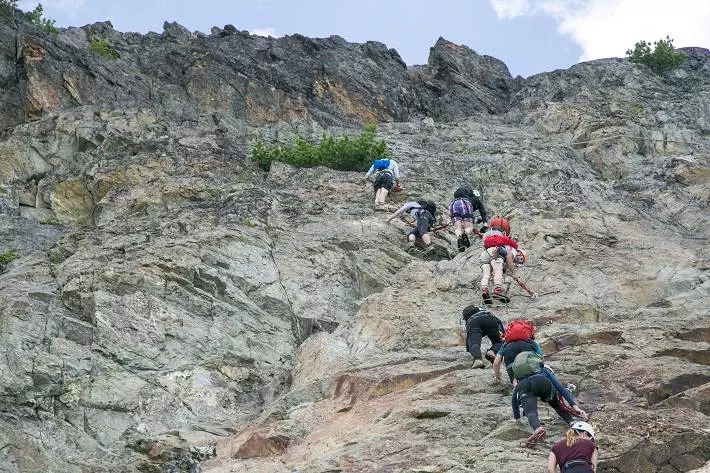Via Ferrata (or “klettersteig” in German-speaking nations) is a relatively young pursuit here in North America. But in Europe, its history dates back over a century. While the first via ferrata routes were built to access popular mountain summits more easily, most protected routes in the Alps were a result of military construction. During World War I, the armies of Austria-Hungary, Italy and France manned mountain positions in the areas of the Dolomites and the French-Swiss Alps. Military engineers built ladder routes, underground tunnels and hanging bridges to increase the efficiency of troop movements over mountainous terrain.

One of the commanding officers in charge of French troop movements in Alps was Hugues Tricand de la Goutte of the 28th Battalion Chasseurs Alpins (“alpine hunters”). He earned a “Chevalier de la Legion D’honneur” medal (equivalent to the British Victoria Cross) at Battle of Hartmannswillerkopf in 1915. De la Goutte trained his troops in mountain warfare, where skills like mountain climbing, skiing and endurance to cold weather were vital to an alpine soldier’s survival. As part of the fortification made by the French army in the Alps on the Italian border, he also oversaw troop and supply logistics, reconnaissance missions and built some of the via ferrata routes that are still intact today.

Gazing up at the laddered ascent embedded into the rock face above him, Eric Dumerac’s face exudes a strong sense of pride. The owner and lead guide of Mountain Skills Academy & Adventures (MSAA), he built this via ferrata route in Squamish, BC all by himself; drilling into the rock, placing every rung and anchor and assuring that all safety mechanisms were in place. Yet his connection with via ferrata goes well beyond mountain climbing. Eric Dumerac is the great-grandson of Hugues Tricand de la Goutte.

“When I was guiding in Europe I had a fascination with these via ferratas,” says Dumerac, who hails from Quebec. “All these years later, here I am building via ferrata routes in British Columbia, just like my great-grandfather did over a hundred years ago.”
There’s an inescapable irony that this recreational metal infrastructure was once used as a tool of war. The thrill of via ferrata comes from climbing rock faces that you wouldn’t otherwise be able to, whereas a century ago it helped thousands of troops gain an advantage over the enemy.

“As an accomplished climber, I think of via ferrata as a sort of ‘vacation on the verticals,’ it can still be such a rewarding experience without the challenge of rock climbing,” says Dumerac. “For others climbing for the first time, it’s an opportunity for them to discover that vertical world in an easier, safer fashion and have fun at the same time. It’s a stark contrast to what the original via ferrata routes were designed for in the Alps, which was moving troops through the mountains for combat.”
With MSAA operating via ferrata tours in both Squamish and Whistler and having just launched the new Whistler Skywalk, Dumerac carries on the legacy of his military ancestor, but for a much more peaceful purpose.
Written by: Vince Shuley


